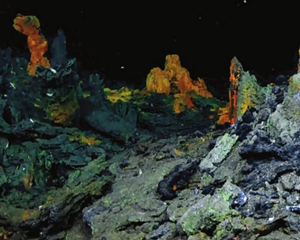Decades in the making, these missions collectively cost billions of dollars.
這些任務歷經幾十年策劃,花費了幾十億美元。
To prepare for astrobiological exploration so far afield, scientists are testing their instruments and techniques in the cold, dark corners of our own backyard.
為了準備在離地球很遠的地方進行太空生物學的探索,科學家正在地球的黑暗與寒冷角落測試儀器和技術。
Even though Titan's surface chemistry is hard to replicate in the field, the seas in the innards of these three moons may not be so unlike our watery environments.
盡管土衛六表面的化學成分很難復制,但這三顆衛星內部的海洋跟我們的水環境可能沒有那么不同。
From Earth's surface to its subterranean caverns, these investigations study some of the most alien creatures on our planet.
從地表到地下洞穴,有許多調查研究了地球上最像外星生命的一些生物。
Their discoveries could even write the story of life's beginnings here, and maybe elsewhere.
這些調查的發現甚至可能證明地球或其他星球的生命起源。
I first pressed a boot print into the Svalbard snow four years ago, as I prepared to board the Norwegian icebreaker Kronprins Haakon -- a shiny new vessel back then -- along with three dozen scientists and engineers.
四年前,我第一次踏上斯瓦巴群島,我和三十幾名科學家和工程師準備登上挪威破冰船哈康王子號。
We launched from Longyearbyen and sailed toward a fractured patch of seafloor north of Greenland.
我們從隆雅市出發,前往格陵蘭北方一處破碎的海床。
There, some two and a half miles down, the Earth heaves searing dark fluids into the sea, forming what is known as the Aurora hydrothermal vent field.
在那個地點的海面下半英里處,地球將炙熱的黑色液體噴入海中,形成了奧洛拉海底熱泉區。
Salt water mingling with hot rocks beneath the seafloor powers these eruptions, which produce the heat and chemistry needed for organisms to thrive.
咸水與海床下炙熱的巖石交互作用,驅動了噴發,進而產生生物繁衍所需的熱量與化學物質。
"They can host all kinds of weird and wonderful life-forms," said Chris German, a marine geochemist from the Woods Hole Oceanographic Institution who has spent nearly four decades hunting hydrothermal vents, as we cruised north.
任職于伍茲霍爾海洋學研究院的海洋地球化學家克里斯·杰爾曼花了將近40年尋找海底熱泉,在我們向北航行時,他說:“那里可能棲息各種奇怪又奇妙的生命形式。”
Under permanent ice cover, the field could be a superlative earthly analogue for the seafloors of Europa and Enceladus.
在永凍的冰層底下,這個海底熱泉區可能是地球上與木衛二和土衛二的海床最類似的地方了。

To explore Aurora, German and his colleagues brought one of the most advanced uncrewed submersibles on Earth: an orange, minivan-size vehicle called NUI, short for Nereid Under Ice.
為了探索奧洛拉海底熱泉,杰爾曼和同事用上了地球上最先進的無人潛水器:橘色、廂式休旅車大小的“冰下海女神”(NUI)。
Festooned with stickers, some reflecting a recent collaboration between Woods Hole and NASA, the three-million-dollar machine is designed to explore under-ice ecosystems.
這臺要價300萬美元的機器,專門用來探索冰下的生態系統,上面貼滿了貼紙,其中一些反映了伍茲霍爾海洋學研究院和美國宇航局最近的合作。
It can dive three miles down, swim more than 25 miles, and operate for half a day without recharging.
它可以下潛到3英里深,航行超過25英里,續航力可達12小時。
NUI functions autonomously, but it can also be remotely piloted; scientists watching live feeds from its cameras can direct it to collect particular sediments or organisms.
NUI可以自主運作,也可遠端遙控,科學家能夠看著攝影機傳來的即時畫面,指示它采集特定的沉積物或生物。
"Our hope is that NUI is kind of like the Australopithecus or Homo habilis to the robotic spacecraft that would one day go to Europa," Kevin Hand, a National Geographic Explorer and astrobiologist at JPL, told the team as the ship plowed through our planet's frozen crust.
當破冰船劃過海面的冰層時,噴射推進實驗室的太空生物學家、也是國家地理探險家的凱文·漢德告訴團隊:“我們希望NUI是未來可前往木衛二的太空船原型,有點像自動太空船界的南方古猿或能人。”
For him, Europa is a tantalizing target in the quest to know whether we are alone in the universe.
對他來說,木衛二是一個誘人的目標,他想知道我們是否在宇宙中是孤獨的。
For days, thick ice -- too bulky for the ship to break -- had slowed our journey to the vents.
連日來的厚冰讓破冰船難以前進,拖慢了我們前往海底熱泉的行程。
Although the going was tricky, the Arctic Ocean's relatively thin icy rind is a friendlier version of the crusts encasing alien oceans.
盡管旅程艱辛,但北冰洋的冰層比包覆外星海洋的冰殼來得薄,已經比較可親了。
The shell at Enceladus may be less than a mile thick at the south pole, where the geysers erupt, but estimates for Europa's rind suggest it's considerably thicker.
土衛二的外殼在間歇泉噴發的南極可能不到1英里厚,但是根據估計,木衛二的外殼顯然厚多了。
Characterizing Europa's frozen shell and the compounds on its surface is one of the highest priorities for both the Europa Clipper and JUICE missions.
木衛二獨特的冰凍外殼及其表面的化合物是木衛二快艇號和JUICE任務的最高優先事項之一。
Those spacecraft will make multiple flybys of Europa to measure the ice shell's thickness and study its layers and ocean beneath, in hopes that with more information, future missions can get through the rind and access the water.
這些航天器將多次飛越木衛二,測量冰殼的厚度,并研究冰層和底下的海洋,希望透過更多的資訊讓未來的任務能夠穿過冰殼取水。
When NASA's Cassini spacecraft zoomed around the Saturn system from 2004 to 2017, it sampled the Enceladian plume multiple times and found salts, silica, organic molecules, and molecular hydrogen, all telltale signs of seafloor activity.
從2004到2017年,NASA的卡西尼號太空船在繞行土星系統時,對土衛二的羽流進行了多次探樣,發現了鹽、二氧化硅、有機分子和氫分子,全都是有海底活動的明顯跡象。
It also detected phosphorus, an element that's crucial for life on Earth.
卡西尼號也偵測到磷這種對地球生命很重要的元素。
NUI's job on this cruise was to get the first good look at the Aurora vent field and help figure out whether it's fueling chemical reactions that can support abyssal life-forms—perhaps the kind of life that might evolve in dark, permanently ice-covered alien seas.
在這次航行中,NUI的任務是對奧洛拉海底熱泉區進行首次詳細觀察,設法弄清它是否促成了能支持深海生命形式的化學反應,而這些生命形式或許能在黑暗且永久被冰層覆蓋的外星海洋里演化。












